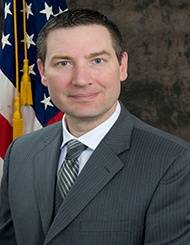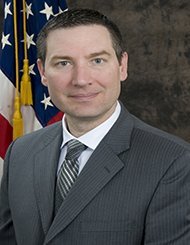
FDA combining agile, cloud to create microservices framework
Todd Simpson, the chief information officer at the Food and Drug Administration, said its cloud advisory board and innovation lab work together to bring new...
FDA CIO Todd Simpson took part in an Ask the CIO online chat on July 25. To read the transcript, please register.
The Food and Drug Administration is finding a happy medium between innovation, and the rigor and process necessary to be successful.
A new cloud advisory board and innovation lab are working together to evaluate an idea and decide whether to move forward.
Todd Simpson, the chief information officer at the Food and Drug Administration, said this new process recently brought a project to fruition.
“One of our centers did an infant formula tracking database. They used the cloud. It went through our intake process, and it went through the requirements analysis process and then it got to the alternative analysis process. Then we used the Enterprise Portfolio Lifecycle Management methodology that HHS uses,” Simpson said during an interview on Ask the CIO. “So we have these toll gates for next steps and when we got to the alternative analysis stage that’s where we had to invoke the cloud advisory board. They review all the different options and worked with the customer.”

Simpson said the board highlighted an existing vendor at the FDA who could provide agile development on a software-as-a-service cloud platform. The FDA center decided to use that vendor to release the new database in nine months—from conception to production.
“That’s a phenomenal accomplishment. That’s the power of this process especially when you couple it with a cloud service provider whose job it is to do agile development within this microservices framework,” he said. “The cloud services provider is part of our overall microservices strategy.”
The FDA has been working toward a microservices architecture over the last few years.
Within a microservices architecture, organizations build apps that are independently deployable, easy to replace, often times organized around specific capabilities, can be implemented using different programming languages and build using automated processes.
Simpson said the FDA’s implementation of cloud computing over the last 18 months, including implementing a cloud broker approach and setting up blanket purchase agreements (BPAs) to more easily buy infrastructure-, platform- and software-as-a-service from, is foundational to the microservices approach.
“We are moving toward this agile development methodology. We want to be able to actively engage our customers when we are doing development so we can get to production quicker,” he said. “When you couple that agile methodology with a microservices framework, which is a toolbox of options to develop software to meet specific requirements.”
Simpson said the microservices framework also will help the FDA move away from a center-centric support model where there are dedicated teams. Instead, the teams will focus on products or capabilities.
FDA just hired a new development director to put together the microservices roadmap.
Simpson said while this is a departure from the norm, there is no reason to worry as the customers’ needs continue to come first.
“We have nine separate centers and our development group is basically broken down into nine different teams under four or five different leaders,” he said. “In the past, as unfortunate as this may sound, when a request for a new project would come in, there was not always a lot of scrutiny that would be involved in the necessity of the investment or the duplication phenomena we talked about. There wasn’t a lot of review. What we really are doing is moving toward a shared service model of development where its development as a service instead of development centered around teams that need to be created with every new project.”
Simpson added the goal of the microservices roadmap is to further flush out the models to ensure they are providing better development services that are cost effective, lends itself to interoperability and greatly reduces duplication of technology.
Simpson said he hopes the FDA centers know they have a CIO’s office that is listening to their challenges and finding solutions to meet their mission needs.
“That’s all about building trust and it’s also about getting the right technology in place so the model works for everyone,” he said. “We don’t want is to have an incomplete model. We don’t want it to have pieces because as long as we have pieces, the customers will have to go out on their own to fill those holes. And every time they do that, we risk interoperability; we risk divergence from the standard; we risk system duplication.”
For the FDA, moving data and systems to the cloud and taking advantage of microservices are part of a broader initiative around modernizing and stabilizing the agency’s IT environment.
Simpson said he’s also focused on network optimization, how artificial intelligence and machine learning can improve their data analysis efforts, improving the FDA’s high performance computing environment and becoming more mobile friendly for employees and citizens.
“Over the last six months, we upgraded all 62 of our firewalls. It was a huge momentous lift and we did it pretty much seamless,” he said. “We are moving more across the wire so our network has to be able to support the change in our business model. Where we used to have a big pipe on our local area network, now we have to get to a cloud. As we start to shift the business model move more into the cloud, we will need more and more bandwidth.”
Simpson said FDA initiated moving to Internet 2 in 2015 and now is embarking on phase 2 of that effort to continue to enrich the network.
FDA gave employees a choice in terms of what kind of mobile device they want to use, Apple or Android or Windows, and put tablets in the hands of field inspectors.
“We automated our field inspection process. We have done 23,000 field inspections through the new process and that is a direct result of our mobility program,” Simpson said. “Now that our customers have these smartphones and tablets, what’s the next step? That is the evolution piece. What’s big and what’ the next priority for us, I think it is virtual desktop interface from smartphones. Also, the mobile app development, which is part of the microservices framework.”
Copyright © 2025 Federal News Network. All rights reserved. This website is not intended for users located within the European Economic Area.
Jason Miller is executive editor of Federal News Network and directs news coverage on the people, policy and programs of the federal government.
Follow @jmillerWFED
Related Stories






